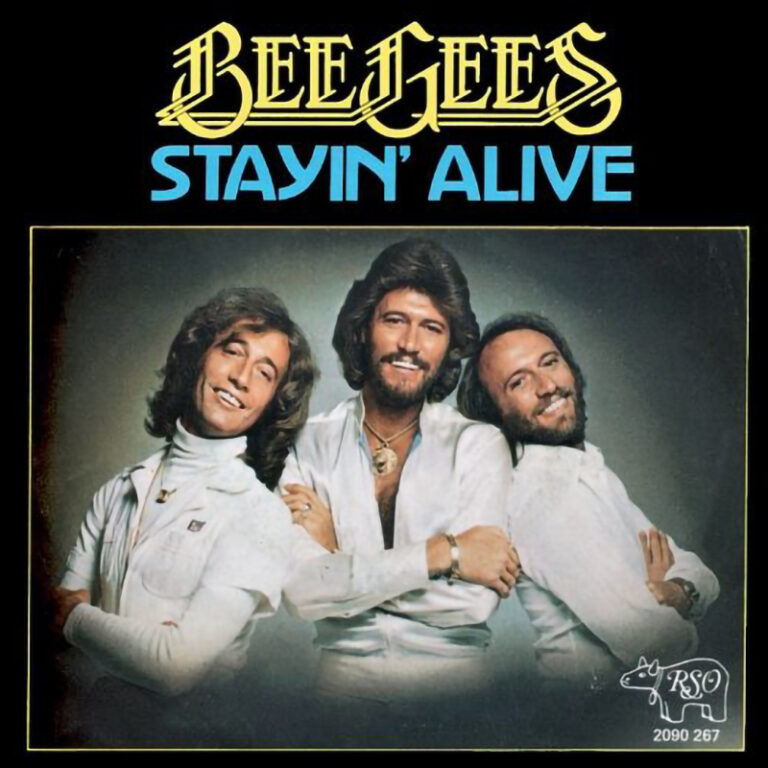3

Stayin' Alive - Bee Gees

B-Side: If I Can’t Have You
From the Album: Saturday Night Fever
Released: 13 December 1977 (US)
Recorded: 1977
Studio: Château d’Hérouville (France), Criteria (Miami)
Genre: Disco
Length: 4:45, 3:25 (single version)
Label: RSO (RSO 885)
Songwriter(s): Barry Gibb, Robin Gibb, Maurice Gibb
Producer(s): Bee Gees, Albhy Galuten, Karl Richardson
The Bee Gees’ saga can be neatly divided into four parts: their Days of Development (1956-66), the Ethereal Era (1967-69), the Ballad Boom (1970-74), and the Disco Deluge (1975-79). The latter period, of course, was when they hit their peak — creatively, and commercially.
Their immense popularity, though, was a distant dream in 1974. The group had been making two million a year in the late sixties, but then, after a string of hits, they fell apart. A comeback in the early seventies yielded such million-sellers as “Lonely Days” and “How Can You Mend a Broken Heart,” but that success was short-lived.
Then, in 1975, the rhythm of their car tires on a Florida bridge inspired “Jive Talkin’,” their first number-one hit in four years. They thought of it as just an R&B tune, but when the record took off in dance halls, the Bee Gees were suddenly cast as “disco kings.” Barry, Robin, and Maurice were not entirely sure as to what that meant, but were determined to find out. By the end of the decade, they had not only mastered the music, but defined, shaped, and epitomized its potential.
Each hit after “Jive Talkin'” seemed more impressive than the last, as the brothers explored and shattered the limits of disco. In 1975, there were “Nights on Broadway” and “Fanny (Be Tender with My Love)”; in 1976, “You Should Be Dancing” and “Love So Right.” They started 1977 with their sixth major dance record, “Boogie Child.”
And then they got a phone call.
It seems that their manager, Robert Stigwood, had been talking to an English writer, Nik Cohen, who was based in New York. Nik told Robert that he’d send him some ideas for movies. Stigwood saw Cohen’s New York magazine cover story about discomania, and rang him up.
“Who needs ideas?” said Stigwood. “Let’s do your magazine piece.”
“He rang us up,” said Robin, “and said, ‘Would you like to do the soundtrack for a film? We said, ‘What film?’ He said, ‘A film I’m making. I haven’t even got a title for it yet. Maybe you could think of that, too.’ ‘How many songs?’ ‘Oh, about six or seven.’ I said, ‘Well, that’s about one a day. When will you send us a script?’ He said, ‘Well, I don’t have a script. You’ll just have to get on with the soundtrack.’ ‘Well, I said, ‘You haven’t got a script, and we haven’t got any songs, so we’re equal, we’re even.’ I put down the phone, and we went to work.”
The brothers actually wrote “Stayin’ Alive” on a staircase at the chateau.
“Years ago, there were many porno films made here,” said Robin. “The staircase where we wrote ‘Stayin’ Alive,’ ‘How Deep Is Your Love,’ and all of those songs was the same staircase used in about six classic porno movies.”
Barry recalled other details of “Stayin’ Alive,” which he called “a desperate plea for help.”
“Robert wanted a scene that was eight minutes long, where Travolta was dancing with this girl,” he said. “It would have a nice dance tempo, then a romantic interlude, and all hell breaking loose at the end. I said, ‘Robert, that’s crazy. We want to put this song out as a single, and we don’t think the rhythm should break. It should go from beginning to end with the same rhythm, and get stronger all the way. To go into a lilting ballad just doesn’t make sense.’ The film got changed.”
“Stayin’ Alive” wound up opening Saturday Night Fever, as John Travolta struts along a city sidewalk. A teasing thirty seconds of that scene was shown in fifteen hundred theaters a week before the movie actually opened. A record was not yet available, but people began calling RSO anyway, asking for “Stayin’ Alive.”
The single broke in mid-December 1977, spending four weeks at number one in February 1978. It was on the charts for more than six months, and won a Grammy for Best Arrangement for Voices.
“Stayin’ Alive” is about survival in the big city — any big city — but basically New York,” said Robin. “When we saw the film we were surprised that it fit so well. It just amazed us, since we’d never even seen the script.”





